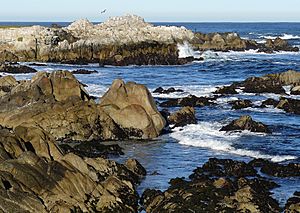Asilomar State Marine Reserve facts for kids
The Asilomar State Marine Reserve (SMR) is a special ocean area where marine life is protected. It's one of four such areas near the cities of Monterey and Pacific Grove in California. These areas are found at the southern end of Monterey Bay. Together, these four protected areas cover about 2.96 square miles (7.67 square kilometers). In the Asilomar SMR, all ocean animals and plants are safe. You cannot fish or take anything living from this reserve.
Contents
Why Asilomar SMR Was Created
The Asilomar State Marine Reserve was set up in September 2007. The California Department of Fish and Game created it. This reserve was part of a bigger plan called the Marine Life Protection Act Initiative. This plan aimed to create a network of protected ocean areas all along California's coast.
The reserve helps protect some of the most visited parts of the central coast. These are areas close to the shore. At the same time, most of the ocean waters nearby are still open for fishing.
Where Asilomar SMR Is Located
The Asilomar SMR is located off the coast of the Monterey Peninsula. This is at the southern end of Monterey Bay. The reserve covers an area of about 1.51 square miles (3.91 square kilometers). It is right next to Asilomar State Beach.
Asilomar SMR is the most western of the four protected ocean areas near the Monterey Peninsula. It is next to the Pacific Grove Marine Gardens State Marine Conservation Area. Further east are the Lovers Point State Marine Reserve and the Edward F. Ricketts State Marine Conservation Area. All four of these areas are part of the larger Monterey Bay National Marine Sanctuary.
The boundaries of this special ocean area are set by the high tide line. They also follow straight lines connecting these points:
- 36°38.22′N 121°56.15′W / 36.63700°N 121.93583°W
- 36°38.90′N 121°56.60′W / 36.64833°N 121.94333°W
- 36°36.60′N 121°57.50′W / 36.61000°N 121.95833°W
Ocean Life and Habitats
The Monterey Peninsula is famous for its amazing tidepools. These are small pools of water left behind by the tide. They are full of different kinds of ocean life. The sandy beaches here are also used by harbor seals to have their pups.
Offshore, there are thick kelp beds. These underwater forests provide shelter for animals like sea otters. The Asilomar SMR is home to many different marine animals and plants. It includes kelp forests, sandy beaches, rocky areas between tides (called the intertidal zone), and both soft and hard ocean bottoms.
Fun Things to Do and See Nearby
Millions of people visit the Monterey Peninsula every year. They come from all over the world to enjoy the ocean and its natural beauty. More than 60,000 scuba divers visit because it's easy to get to the water. They also love the many types of wildlife and the beautiful kelp forests.
The Monterey Bay Aquarium is a popular place to visit. It has a huge living kelp forest exhibit, which is 28 feet (8.5 meters) tall. This exhibit shows animals that live in the nearby protected ocean areas. The aquarium also has sea otters, tidepool creatures, and sometimes even sea turtles.
Besides diving and visiting the aquarium, visitors to Monterey Bay can enjoy many other activities. These include kayaking, whale watching, surfing, and bird watching. You can also explore the tidepools or walk on the beach. Asilomar State Beach, right next to the reserve, has a walking trail that is about 0.75 miles (1.2 kilometers) long.
California’s marine protected areas encourage people to enjoy and learn about the ocean. Activities like kayaking, diving, snorkeling, and swimming are usually allowed.
How Scientists Study the Reserve
Scientists are watching certain marine protected areas along California’s central coast. This is part of the Marine Life Protection Act. They want to see how well these areas are working and learn more about the health of the ocean. Studies in similar protected areas near the Santa Barbara Channel Islands have already shown good results. Fish are getting bigger and there are more of them.
Local science and education groups help with this monitoring. These include the Hopkins Marine Station, the Monterey Bay Aquarium Research Institute (MBARI), and Moss Landing Marine Laboratories. Scientists use different methods to study the ocean. They use hook-and-line sampling, send scuba divers down, and even use special underwater robots called Remote Operated Vehicles (ROVs).


